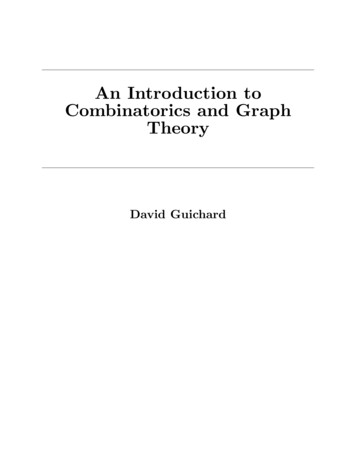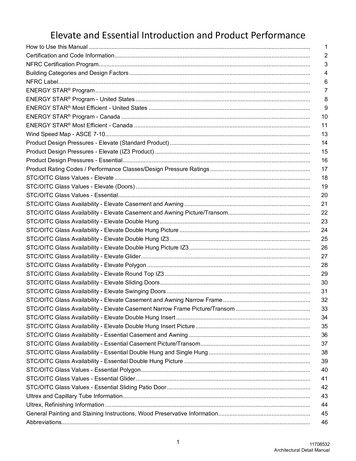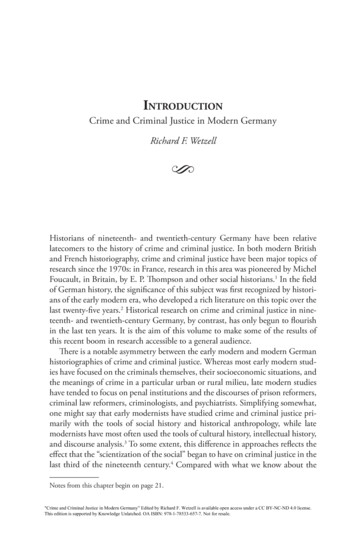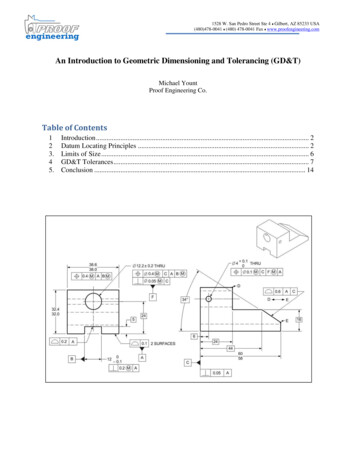
Transcription
An Introduction toCombinatorics and GraphTheoryDavid Guichard
This work is licensed under the Creative Commons Attribution-NonCommercial-ShareAlike License. Toview a copy of this license, visit http://creativecommons.org/licenses/by-nc-sa/3.0/ or send a letter toCreative Commons, 543 Howard Street, 5th Floor, San Francisco, California, 94105, USA. If you distributethis work or a derivative, include the history of the document.This copy of the text was compiled from source at 12:03 on 1/30/2022.We will be glad to receive corrections and suggestions for improvement at guichard@whitman.edu.
les . . . . . . . . . . . .Combinations and permutationsBinomial coefficients . . . . . .Bell numbers . . . . . . . . . .Choice with repetition . . . . .The Pigeonhole Principle . . . .Sperner’s Theorem . . . . . . .Stirling numbers . . . . . . . .7.8111621273135392Inclusion-Exclusion2.12.245The Inclusion-Exclusion Formula . . . . . . . . . . . . . . . . . 45Forbidden Position Permutations . . . . . . . . . . . . . . . . . 483
4Contents3Generating Functions3.13.23.33.43.553Newton’s Binomial Theorem . . .Exponential Generating FunctionsPartitions of Integers . . . . . . .Recurrence Relations . . . . . . .Catalan Numbers . . . . . . . . .53565962664Systems of Distinct Representatives4.14.24.34.44.5Existence of SDRs . . . . . .Partial SDRs . . . . . . . . .Latin Squares . . . . . . . . .Introduction to Graph TheoryMatchings . . . . . . . . . .71.72747683845Graph Theory5.15.25.35.45.55.65.75.85.95.105.11The Basics . . . . . . . .Euler Circuits and Walks .Hamilton Cycles and PathsBipartite Graphs . . . . .Trees . . . . . . . . . . .Optimal Spanning Trees .Connectivity . . . . . . .Graph Coloring . . . . . .The Chromatic PolynomialColoring Planar Graphs . .Directed Graphs . . . . .91. . 91. . 96. 100. 103. 105. 108. 110. 118. 124. 125. 129
Contents56Pólya–Redfield Counting6.16.26.3Groups of Symmetries . . . . . . . . . . . . . . . . . . . . .Burnside’s Theorem . . . . . . . . . . . . . . . . . . . . . .Pólya-Redfield Counting . . . . . . . . . . . . . . . . . . . .135137140146AHints151Index153
1FundamentalsCombinatorics is often described briefly as being about counting, and indeed counting isa large part of combinatorics. As the name suggests, however, it is broader than this: itis about combining things. Questions that arise include counting problems: “How manyways can these elements be combined?” But there are other questions, such as whether acertain combination is possible, or what combination is the “best” in some sense. We willsee all of these, though counting plays a particularly large role.Graph theory is concerned with various types of networks, or really models of networkscalled graphs. These are not the graphs of analytic geometry, but what are often describedas “points connected by lines”, for example: . . . . . The preferred terminology is vertex for a point and edge for a line. The lines need notbe straight lines, and in fact the actual definition of a graph is not a geometric definition.The figure above is simply a visualization of a graph; the graph is a more abstract object,consisting of seven vertices, which we might name {v1 , . . . , v7 }, and the collection of pairsof vertices that are connected; for a suitable assignment of names vi to the points inthe diagram, the edges could be represented as {v1 , v2 },{v2 , v3 },{v3 , v4 },{v3 , v5 },{v4 , v5 },{v5 , v6 },{v6 , v7 }.7
8Chapter 1 Fundamentals1.1 ExamplesSuppose we have a chess board, and a collection of tiles, like dominoes, each of which is thesize of two squares on the chess board. Can the chess board be covered by the dominoes?First we need to be clear on the rules: the board is covered if the dominoes are laid down sothat each covers exactly two squares of the board; no dominoes overlap; and every squareis covered. The answer is easy: simply by laying out 32 dominoes in rows, the board canbe covered. To make the problem more interesting, we allow the board to be rectangularof any size, and we allow some squares to be removed from the board. What can be sayabout whether the remaining board can be covered? This is such a board, for example:.What can we say? Here is an easy observation: each domino must cover two squares, sothe total number of squares must be even; the board above has an even number of squares.Is that enough? It is not too hard to convince yourself that this board cannot be covered;is there some general principle at work? Suppose we redraw the board to emphasize thatit really is part of a chess board:.Aha! Every tile must cover one white and one gray square, but there are four of theformer and six of the latter, so it is impossible. Now do we have the whole picture? No;
1.1Examples9for example:.The gray square at the upper right clearly cannot be covered. Unfortunately it is not easyto state a condition that fully characterizes the boards that can be covered; we will seethis problem again. Let us note, however, that this problem can also be represented asa graph problem. We introduce a vertex corresponding to each square, and connect twovertices by an edge if their associated squares can be covered by a single domino; here isthe previous board: . Here the top row of vertices represents the gray squares, the bottom row the white squares.A domino now corresponds to an edge; a covering by dominoes corresponds to a collectionof edges that share no endpoints and that are incident with (that is, touch) all six vertices.Since no edge is incident with the top left vertex, there is no cover.Perhaps the most famous problem in graph theory concerns map coloring: Given amap of some countries, how many colors are required to color the map so that countriessharing a border get different colors? It was long conjectured that any map could becolored with four colors, and this was finally proved in 1976. Here is an example of a smallmap, colored with four colors:.Typically this problem is turned into a graph theory problem. Suppose we add to eachcountry a capital, and connect capitals across common boundaries. Coloring the capitals so
10Chapter 1 Fundamentalsthat no two connected capitals share a color is clearly the same problem. For the previousmap: .Any graph produced in this way will have an important property: it can be drawn so thatno edges cross each other; this is a planar graph. Non-planar graphs can require morethan four colors, for example this graph: . This is called the complete graph on five vertices, denoted K5 ; in a complete graph,each vertex is connected to each of the others. Here only the “fat” dots represent vertices;intersections of edges at other points are not vertices. A few minutes spent trying shouldconvince you that this graph cannot be drawn so that its edges don’t cross, though thenumber of edge crossings can be reduced.Exercises 1.1.1. Explain why an m n board can be covered if either m or n is even. Explain why it cannotbe covered if both m and n are odd.2. Suppose two diagonally opposite corners of an ordinary 8 8 board are removed. Can theresulting board be covered?3. Suppose that m and n are both odd. On an m n board, colored as usual, all four cornerswill be the same color, say white. Suppose one white square is removed from any locationon the board. Show that the resulting board can be covered.4. Suppose that one corner of an 8 8 board is removed. Can the remainder be covered by1 3 tiles? Show a tiling or prove that it cannot be done.
1.2Combinations and permutations115. Suppose the square in row 3, column 3 of an 8 8 board is removed. Can the remainder becovered by 1 3 tiles? Show a tiling or prove that it cannot be done.6. Remove two diagonally opposite corners of an m n board, where m is odd and n is even.Show that the remainder can be covered with dominoes.7. Suppose one white and one black square are removed from an n n board, n even. Showthat the remainder can be covered by dominoes.8. Suppose an n n board, n even, is covered with dominoes. Show that the number of horizontaldominoes with a white square under the left end is equal to the number of horizontal dominoeswith a black square under the left end.9. In the complete graph on five vertices shown above, there are five pairs of edges that cross.Draw this graph so that only one pair of edges cross. Remember that “edges” do not haveto be straight lines.10. The complete bipartite graph K3,3 consists of two groups of three vertices each, with allpossible edges between the groups and no other edges:. . . . . . . . . . . . . . . . . . . . . . . . . . . . . . . . . . . . . . . . . . . . . . . . . . Draw this graph with only one crossing. 1.2 Combinations and permutationsWe turn first to counting. While this sounds simple, perhaps too simple to study, it isnot. When we speak of counting, it is shorthand for determining the size of a set, or moreoften, the sizes of many sets, all with something in common, but different sizes dependingon one or more parameters. For example: how many outcomes are possible when a die isrolled? Two dice? n dice? As stated, this is ambiguous: what do we mean by “outcome”?Suppose we roll two dice, say a red die and a green die. Is “red two, green three” adifferent outcome than “red three, green two”? If yes, we are counting the number ofpossible “physical” outcomes, namely 36. If no, there are 21. We might even be interestedsimply in the possible totals, in which case there are 11 outcomes.Even the quite simple first interpretation relies on some degree of knowledge aboutcounting; we first make two simple facts explicit. In terms of set sizes, suppose we knowthat set A has size m and set B has size n. What is the size of A and B together, that is,the size of A B? If we know that A and B have no elements in common, then the sizeA B is m n; if they do have elements in common, we need more information. A simplebut typical problem of this type: if we roll two dice, how many ways are there to get either7 or 11? Since there are 6 ways to get 7 and two ways to get 11, the answer is 6 2 8.Though this principle is simple, it is easy to forget the requirement that the two sets be
12Chapter 1 Fundamentalsdisjoint, and hence to use it when the circumstances are otherwise. This principle is oftencalled the addition principle.This principle can be generalized: if sets A1 through An are pairwise disjoint and have nsizes m1 , . . . mn , then the size of A1 · · · An i 1 mi . This can be proved by a simpleinduction argument.Why do we know, without listing them all, that there are 36 outcomes when two diceare rolled? We can view the outcomes as two separate outcomes, that is, the outcomeof rolling die number one and the outcome of rolling die number two. For each of 6outcomes for the first die the second die may have any of 6 outcomes, so the total is6 6 6 6 6 6 36, or more compactly, 6 · 6 36. Note that we are really using theaddition principle here: set A1 is all pairs (1, x), set A2 is all pairs (2, x), and so on. Thisis somewhat more subtle than is first apparent. In this simple example, the outcomes ofdie number two have nothing to do with the outcomes of die number one. Here’s a slightlymore complicated example: how many ways are there to roll two dice so that the two dicedon’t match? That is, we rule out 1-1, 2-2, and so on. Here for each possible value ondie number one, there are five possible values for die number two, but they are a differentfive values for each value on die number one. Still, because all are the same, the result is5 5 5 5 5 5 30, or 6 · 5 30. In general, then, if there are m possibilities for oneevent, and n for a second event, the number of possible outcomes for both events togetheris m · n. This is often called the multiplication principle.In general, if n events have mi possible outcomes, for i 1, . . . , n, where each mi isunaffected by the outcomes of other events, then the number of possible outcomes overall nis i 1 mi . This too can be proved by induction.EXAMPLE 1.2.1 How many outcomes are possible when three dice are rolled, if no twoof them may be the same? The first two dice together have 6 · 5 30 possible outcomes,from above. For each of these 30 outcomes, there are four possible outcomes for the thirddie, so the total number of outcomes is 30 · 4 6 · 5 · 4 120. (Note that we consider thedice to be distinguishable, that is, a roll of 6, 4, 1 is different than 4, 6, 1, because the firstand second dice are different in the two rolls, even though the numbers as a set are thesame.)EXAMPLE 1.2.2 Suppose blocks numbered 1 through n are in a barrel; we pull out kof them, placing them in a line as we do. How many outcomes are possible? That is, howmany different arrangements of k blocks might we see?This is essentially the same as the previous example: there are k “spots” to be filled byblocks. Any of the n blocks might appear first in the line; then any of the remaining n 1might appear next, and so on. The number of outcomes is thus n(n 1)(n 2) · · · (n k 1),by the multiplication principle. In the previous example, the first “spot” was die number
1.2Combinations and permutations13one, the second spot was die number two, the third spot die number three, and 6 · 5 · 4 6(6 1)(6 2); notice that 6 2 6 3 1.This is quite a general sort of problem:DEFINITION 1.2.3The number of permutations of n things taken k at a time isP (n, k) n(n 1)(n 2) · · · (n k 1) n!.(n k)!A permutation of some objects is a particular linear ordering of the objects; P (n, k)in effect counts two things simultaneously: the number of ways to choose and order k outof n objects. A useful special case is k n, in which we are simply counting the numberof ways to order all n objects. This is n(n 1) · · · (n n 1) n!. Note that the secondform of P (n, k) from the definition givesn!n! .(n n)!0!This is correct only if 0! 1, so we adopt the standard convention that this is true, thatis, we define 0! to be 1.Suppose we want to count only the number of ways to choose k items out of n, that is,we don’t care about order. In example 1.2.1, we counted the number of rolls of three dicewith different numbers showing. The dice were distinguishable, or in a particular order: afirst die, a second, and a third. Now we want to count simply how many combinations ofnumbers there are, with 6, 4, 1 now counting as the same combination as 4, 6, 1.EXAMPLE 1.2.4 Suppose we were to list all 120 possibilities in example 1.2.1. The listwould contain many outcomes that we now wish to count as a single outcome; 6, 4, 1 and4, 6, 1 would be on the list, but should not be counted separately. How many times will asingle outcome appear on the list? This is a permutation problem: there are 3! orders inwhich 1, 4, 6 can appear, and all 6 of these will be on the list. In fact every outcome willappear on the list 6 times, since every outcome can appear in 3! orders. Hence, the list istoo big by a factor of 6; the correct count for the new problem is 120/6 20.Following the same reasoning in general, if we have n objects, the number of ways tochoose k of them is P (n, k)/k!, as each collection of k objects will be counted k! times byP (n, k).
14Chapter 1 FundamentalsDEFINITION 1.2.5n-set) isThe number of subsets of size k of a set of size n (also called an( )P (n, k)n!nC(n, k) .k!k!(n k)!k( )The notation C(n, k) is rarely used; instead we use nk , pronounced “n choose k”.EXAMPLE 1.2.6 Consider n 0, 1, 2, 3. It is easy to list the subsets of a small n-set; atypical n-set is {a1 , a2 , . . . , an }. A 0-set, namely the empty set, has one subset, the emptyset; a 1-set has two subsets, the empty set and {a1 }; a 2-subset has four subsets, , {a1 },{a2 }, {a1 , a2 }; and a 3-subset has eight: , {a1 }, {a2 }, {a3 }, {a1 , a2 }, {a1 , a3 }, {a2 , a3 },( ){a1 , a2 , a3 }. From these lists it is then easy to compute nk :0n 123k0 1 2 311 11 2 11 3 3 1You probably recognize these numbers: this is the beginning of Pascal’s Triangle.Each entry in Pascal’s triangle is generated by adding two entries from the previous row:( )the one directly above, and the one above and to the left. This suggests that nk (n 1) (n 1)indeed this is true. To make this work out neatly, we adopt thek 1 k , and(n)convention that k 0 when k 0 or k n.THEOREM 1.2.7( ) () ()nn 1n 1 .kk 1kProof. A typical n-set is A {a1 , . . . , an }. We consider two types of subsets: thosethat contain an and those that do not. If a k-subset of A does not contain an , then it is()a k-subset of {a1 , . . . , an 1 }, and there are n 1of these. If it does contain an , then itk()consists of an and k 1 elements of {a1 , . . . , an 1 }; since there are n 1therek 1 (of these,(n 1)) (n 1)n 1are k 1 subsets of this type. Thus the total number of k-subsets of A is k 1 k .()(n 1)(n 1)(n 1)Note that when k 0, n 1 0,andwhenk n, 0,kn(n)(n 1)(n) k 1(n 1) 1so that 0 0 and n n 1 . These values are the boundary ones in Pascal’sTriangle.Many counting problems rely on the sort of reasoning we have seen. Here are a fewvariations on the theme.
1.2Combinations and permutations15EXAMPLE 1.2.8 Six people are to sit at a round table; how many seating arrangementsare there?It is not clear exactly what we mean to count here. If there is a “special seat”, forexample, it may matter who ends up in that seat. If this doesn’t matter, we only careabout the relative position of each person. Then it may or may not matter whether acertain person is on the left or right of another. So this question can be interpreted in (atleast) three ways. Let’s answer them all.First, if the actual chairs occupied by people matter, then this is exactly the sameas lining six people up in a row: 6 choices for seat number one, 5 for seat two, and soon, for a total of 6!. If the chairs don’t matter, then 6! counts the same arrangement toomany times, once for each person who might be in seat one. So the total in this case is6!/6 5!. Another approach to this: since the actual seats don’t matter, just put oneof the six people in a chair. Then we need to arrange the remaining 5 people in a row,which can be done in 5! ways. Finally, suppose all we care about is who is next to whom,ignoring right and left. Then the previous answer counts each arrangement twice, once forthe counterclockwise order and once for clockwise. So the total is 5!/2 P (5, 3).We have twice seen a general principle at work: if we can overcount the desired set insuch a way that every item gets counted the same number of times, we can get the desiredcount just by dividing by the common overcount factor. This will continue to be a usefulidea. A variation on this theme is to overcount and then subtract the amount of overcount.EXAMPLE 1.2.9 How many ways are there to line up six people so that a particularpair of people are not adjacent?Denote the people A and B. The total number of orders is 6!, but this counts thoseorders with A and B next to each other. How many of these are there? Think of thesetwo people as a unit; how many ways are there to line up the AB unit with the other 4people? We have 5 items, so the answer is 5!. Each of these orders corresponds to twodifferent orders in which A and B are adjacent, depending on whether A or B is first. Sothe 6! count is too high by 2 · 5! and the count we seek is 6! 2 · 5! 4 · 5!.Exercises 1.2.1. How many positive factors does 2 · 34 · 73 · 112 · 475 have? How many does pe11 pe22 · · · penn have,where the pi are distinct primes?2. A poker hand consists of five cards from a standard 52 card deck with four suits and thirteenvalues in each suit; the order of the cards in a hand is irrelevant. How many hands consistof 2 cards with one value and 3 cards of another value (a full house)? How many consist of5 cards from the same suit (a flush)?
16Chapter 1 Fundamentals3. Six men and six women are to be seated around a table, with men and women alternating.The chairs don’t matter, only who is next to whom, but right and left are different. Howmany seating arrangements are possible?4. Eight people are to be seated around a table; the chairs don’t matter, only who is next towhom, but right and left are different. Two people, X and Y, cannot be seated next to eachother. How many seating arrangements are possible?5. In chess, a rook attacks any piece in the same row or column as the rook, provided no otherpiece is between them. In how many ways can eight indistinguishable rooks be placed on achess board so that no two attack each other? What about eight indistinguishable rooks ona 10 10 board?6. Suppose that we want to place 8 non-attacking rooks on a chessboard. In how many wayscan we do this if the 16 most ‘northwest’ squares must be empty? How about if only the 4most ‘northwest’ squares must be empty?7. A “legal” sequence of parentheses is one in which the parentheses can be properly matched,like ()(()). It’s not hard to see that this is possible precisely when the number of left and rightparentheses is the same, and every initial segment of the sequence has at least as many leftparentheses as right. For example, ()) . . . cannot possibly be extendeda) legal sequence.( ) (to2nShow that the number of legal sequences of length 2n is Cn 2n . The numbersnn 1Cn are called the Catalan numbers.1.3 Binomial coefficientsRecall the appearance of Pascal’s Triangle in example 1.2.6. If you have encountered thetriangle before, you may know it has many interesting properties. We will explore some ofthese here.You may know, for example, that the entries in Pascal’s Triangle are the coefficientsof the polynomial produced by raising a binomial to an integer power. For example,(x y)3 1 · x3 3 · x2 y 3 · xy 2 1 · y 3 , and the coefficients 1, 3, 3, 1 form row three of( )Pascal’s Triangle. For this reason the numbers nk are usually referred to as the binomialcoefficients.THEOREM 1.3.1 Binomial Theorem( )( )( )( )n ( )n nn n 1n n 2 2n n n n i in(x y) x xy xy ··· y x y012nii 0Proof. We prove this by induction on n. It is easy to check the first few, say forn 0, 1, 2, which form the base case. Now suppose the theorem is true for n 1, that is,n 1 (n 1)n 1(x y) xn 1 i y i .ii 0Thennn 1(x y) (x y)(x y) (x y)n 1 (i 0)n 1 n 1 i ixy.i
1.3Binomial coefficients17Using the distributive property, this becomesn 1n 1 (n 1) (n 1)n 1 i ixy yxn 1 i y ixiii 0i 0n 1n 1 (n 1) (n 1)n i i x y xn 1 i y i 1 .iii 0i 0These two sums have much in common, but it is slightly disguised by an “offset”: the firstsum starts with an xn y 0 term and ends with an x1 y n 1 term, while the correspondingterms in the second sum are xn 1 y 1 and x0 y n . Let’s rewrite the second sum so that theymatch:n 1n 1 (n 1) (n 1)n i ix y xn 1 i y i 1iii 0i 0()n 1n ( n 1) n 1 n i in i i x y x yii 1i 0i 1()))()n 1 (n 1 (n 1 n n 1 n i i n 1 n i in 1 n x x y x y y0ii 1n 1i 1i 1()()()()n 1n 1 n n 1n 1n 1 nn i i x ( )x y y .0ii 1n 1i 1Now we can use theorem 1.2.7 to get:()) ()()n 1 (n 1 n n 1n 1n 1 nn i ix ( )x y y .0ii 1n 1i 1()()n 1 ( )n 1 n n n i in 1 n x x y y .0in 1i 1( )()( )n 1n n n n i in n x x y y0ini 1()n n xn i y i .ii 0At the next to last step we used the facts that(n 1)0 (n)0and(n 1)n 1 (n)n .Here is an interesting consequence of this theorem: Consider(x y)n (x y)(x y) · · · (x y).One way we might think of attempting to multiply this out is this: Go through the nfactors (x y) and in each factor choose either the x or the y; at the end, multiply your
18Chapter 1 Fundamentalschoices together, getting some term like xxyxyy · · · yx xi y j , where of course i j n.If we do this in all possible ways and then collect like terms, we will clearly getn ai xn i y i .i 0( )We know that the correct expansion has ni ai ; is that in fact what we will get by thismethod? Yes: consider xn i y i . How many times will we get this term using the givenmethod? It will be the number of times we end up with i y-factors. Since there are nfactors (x y), the number of times we get i y-factors must be the number of ways to pick( )i of the (x y) factors to contribute a y, namely ni . This is probably not a useful methodin practice, but it is interesting and occasionally useful.EXAMPLE 1.3.2Using this method we might get(x y)3 xxx xxy xyx xyy yxx yxy yyx yyywhich indeed becomes x3 3x2 y 3xy 2 y 3 upon collecting like terms.The Binomial Theorem, 1.3.1, can be used to derive many interesting identities. Acommon way to rewrite it is to substitute y 1 to getn ( ) n n in(x 1) x .ii 0If we then substitute x 1 we getn ( ) n2 ,ii 0nthat is, row n of Pascal’s Triangle sums to 2n . This is also easy to understand combinatorially: the sum represents the total number of subsets of an n-set, since it adds togetherthe numbers of subsets of every possible size. It is easy to see directly that the number ofsubsets of an n-set is 2n : for each element of the set we make a choice, to include or toexclude the element. The total number of ways to make these choices is 2 · 2 · · · 2 2n , bythe multiplication principle.Suppose now that n 1 and we substitute 1 for x; we getn ( ) nn( 1 1) ( 1)n i .(1.3.1)ii 0The sum is now an alternating sum: every other term is multiplied by 1. Since the lefthand side is 0, we can rewrite this to get( ) ( )( ) ( )nnnn ··· ···.(1.3.2)0213So each of these sums is 2n 1 .
1.3Binomial coefficients19Another obvious feature of Pascal’s Triangle is symmetry: each row reads the sameforwards and backwards. That is, we have:THEOREM 1.3.3( ) ()nn .in iProof. This is quite easy to see combinatorially: every i-subset of an n-set is associatedwith an (n i)-subset. That is, if the n-set is A, and if B A has size i, then thecomplement of B has size n i. This establishes a 1–1 correspondence between sets of sizei and sets of size n i, so the numbers of each are the same. (Of course, if i n i, noproof is required.)Note that this means that the Binomial Theorem, 1.3.1, can also be written as)n ( nn(x y) xn i y i .n ii 0orn(x y) n ( ) ni 0ixi y n i .Another striking feature of Pascal’s Triangle is that the entries across a row are strictlyincreasing to the middle of the row, and then strictly decreasing. Since we already knowthat the rows are symmetric, the first part of this implies the second.THEOREM 1.3.4Proof.For 1 i ⌊ n2 ⌋,( ) ()nn .ii 1This is by induction; the base case is apparent from the first few rows. Write( ) () ()nn 1n 1 ii 1i() () ()nn 1n 1 i 1i 2i 1Provided that 1 i ⌊ n 12 ⌋, we know by the induction hypothesis that() ()n 1n 1 .ii 1n 1Provided that 1 i 1 ⌊ n 12 ⌋, or equivalently 2 i ⌊ 2 ⌋ 1, we know that() ()n 1n 1 .i 1i 2Hence if 2 i ⌊ n 12 ⌋,( ) ()nn .ii 1nThis leaves two special cases to check: i 1 and for n even, i ⌊ n 12 ⌋ 1 ⌊ 2 ⌋. Theseare left as an exercise.
20Chapter 1 FundamentalsExercises 1.3.1. Suppose a street grid starts at position (0, 0) and extends up and to the right:(0, 0)2.3.4.5.A shortest route along streets from (0, 0) to (i, j) is i j blocks long, going i blocks east andj blocks north. How many such routes are there? Suppose that the block between (k, l) and(k 1, l) is closed, where k i and l j. How many shortest routes are there from (0, 0) to(i, j)?(k) (n 1) Prove by induction that nk 0 i i 1 for n 0 and i 0.(k) (n 1) Use a combinatorial argument to prove that nk 0 i i 1 for n 0 and i 0; that is,explain why the left-hand side counts the same thing as the right-hand side.( ) ()( )Use a combinatorial argument to prove that k2 n k k(n k) n2 .2( )Use a combinatorial argument to prove that 2nis even.n6. Suppose that A is a non-empty finite set. Prove that A has as many even-sized subsets as itdoes odd-sized subsets.))(( n (k)for n 0 and i 0.n n 1k n 17. Prove that k 0i 2i 1i(n 1) (n) 28. Verify that 2 2 n2 . Use exercise 2 to find a simple expression for ni 1 i .9. Make a conjecture about the sums of the upward diagonals in Pascal’s Triangle as indicated.Prove your conjecture is true.111111.2 13 3 14 6 4 110. Find the number of ways to write n as an ordered sum of ones and twos, n 0. For example,when n 4, there are five ways: 1 1 1 1, 2 1 1, 1 2 1, 1 1 2, and 2 2.(n) i(n) i 1 n 1a simple expression for11. Use (x 1)n nx . Then find ai 0i 0 i x to (findii 1) nn1simple expression for i 0 i
not. When we speak of counting, it is shorthand for determining the size of a set, or more often, the sizes of many sets, all with something in common, but fft sizes depending on one or more parameters. For example: how many outcomes are possible when a die is rolled? Two dice? n dice? As











